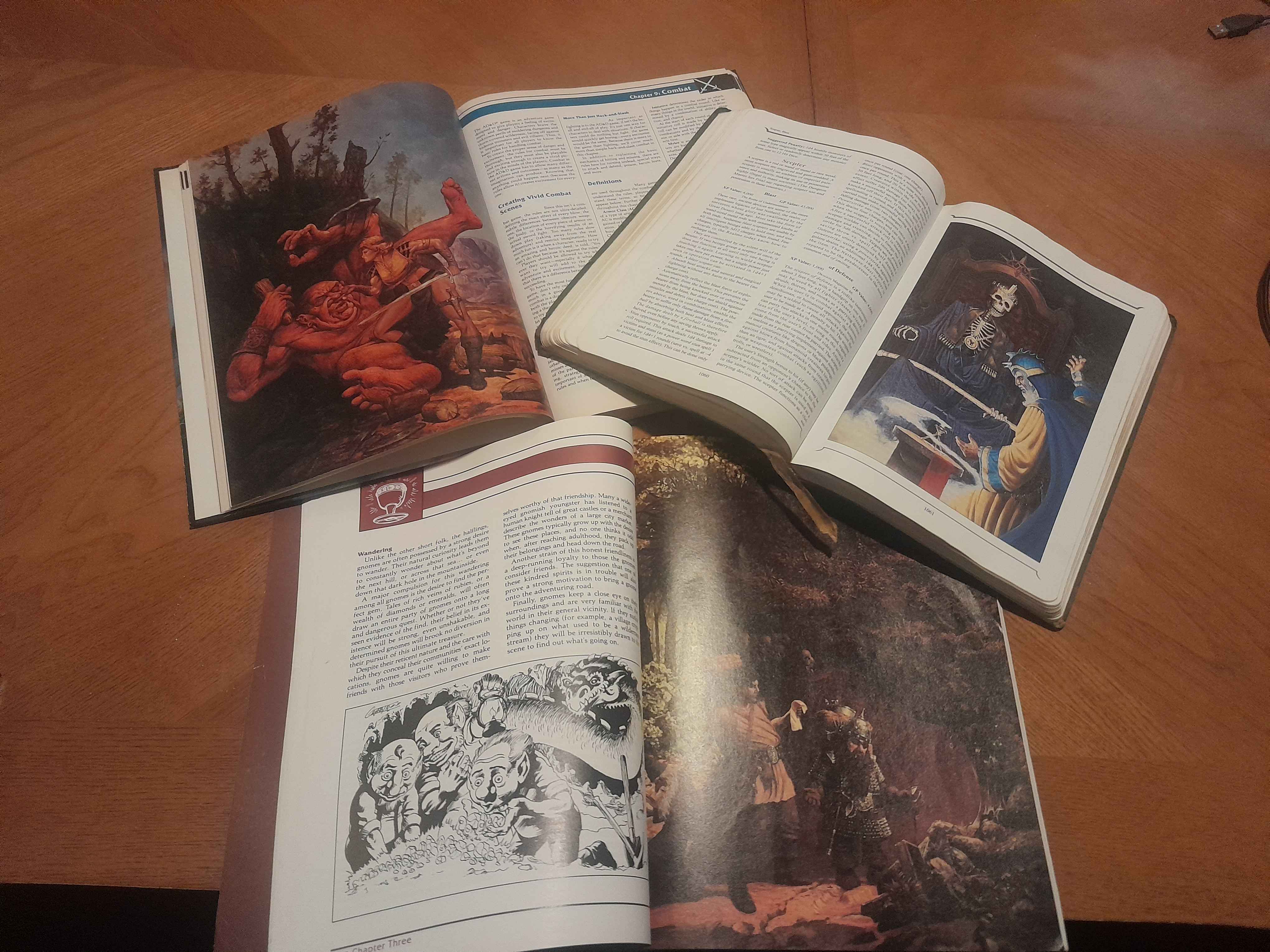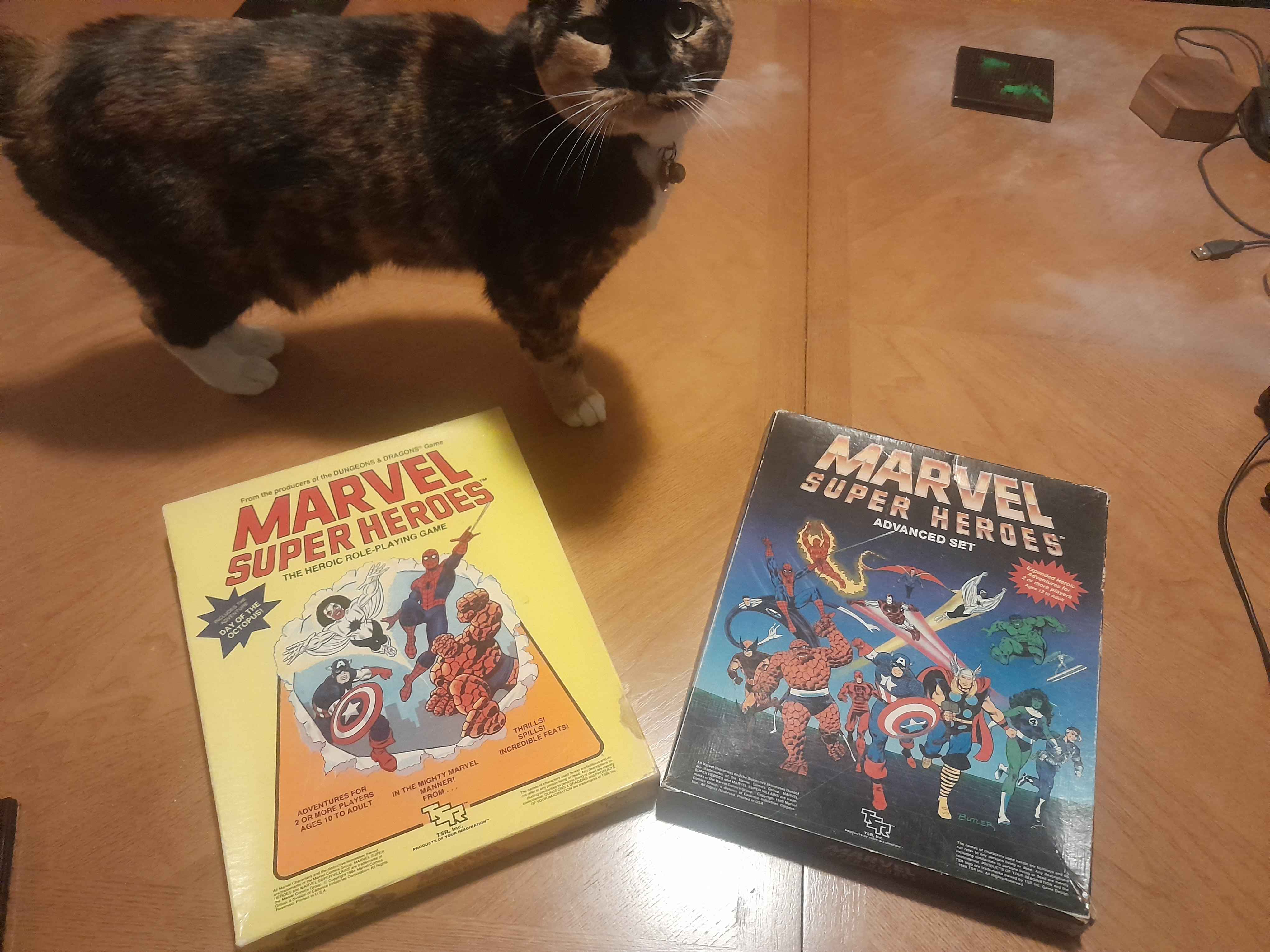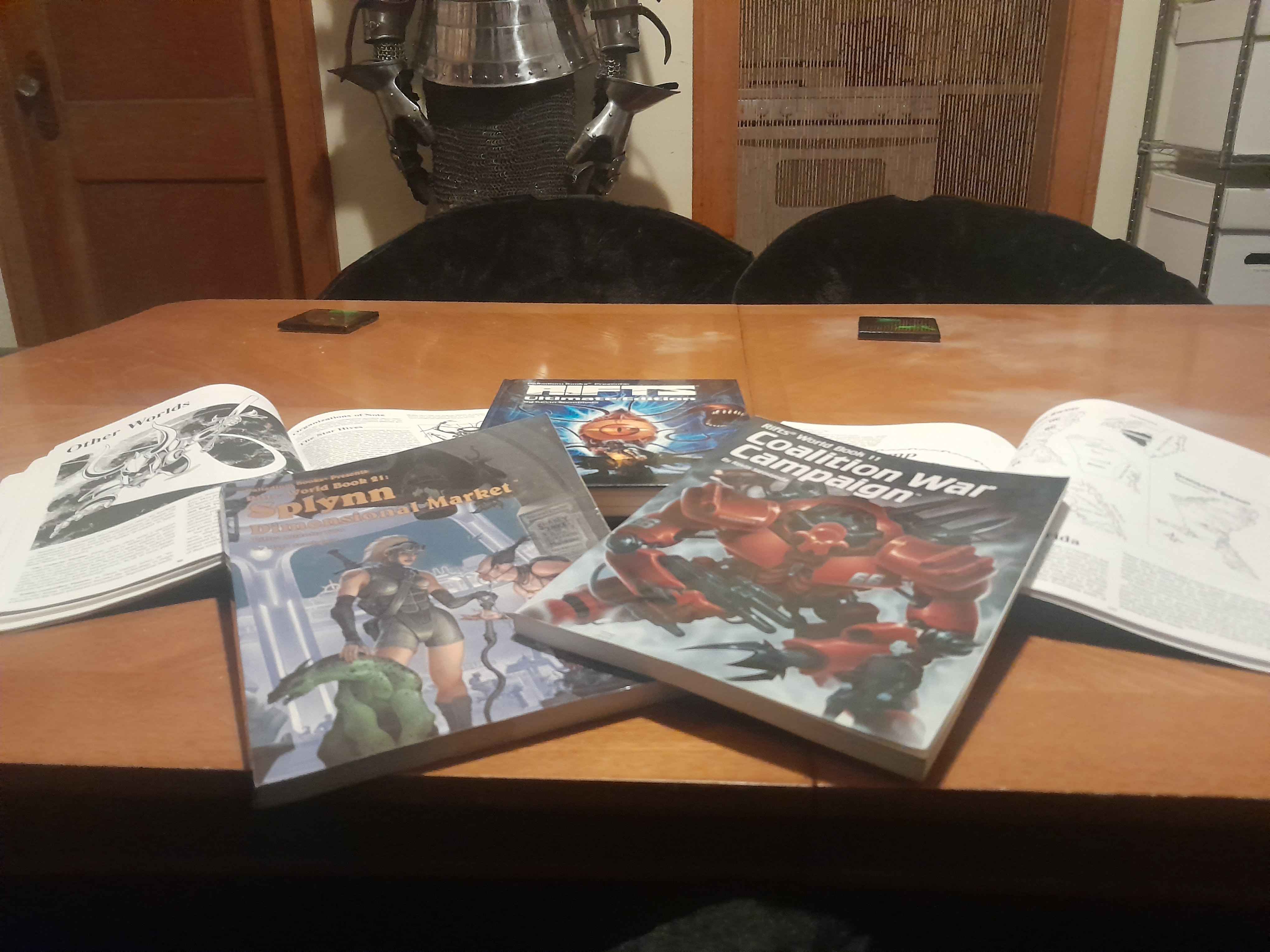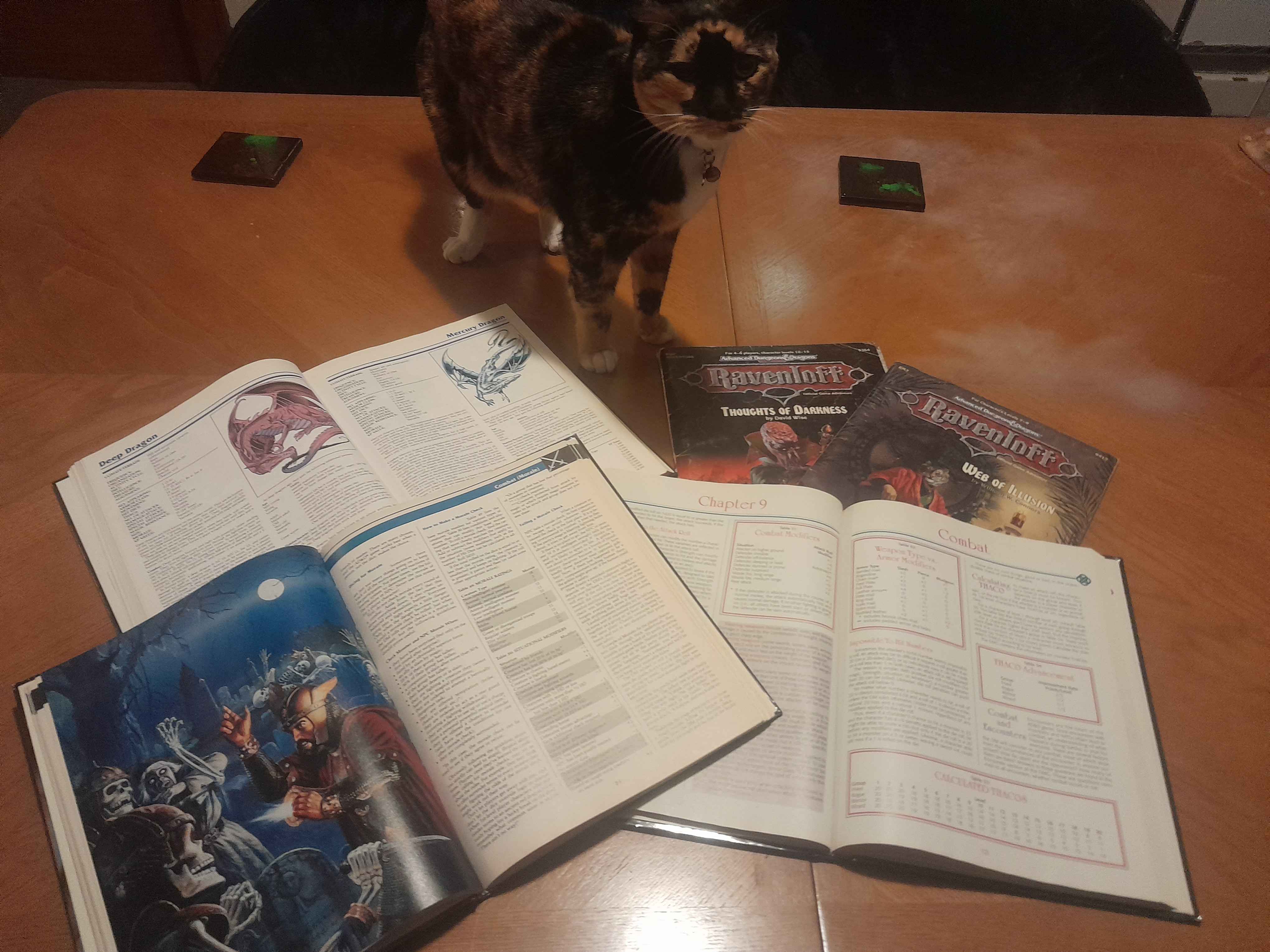I was introduced to DnD by my Dad, who told me that my older brother used to play it before I was born, though he never played himself as far as I am aware. It sounded so amazing, but my Dad and my brother never elaborated on what DnD actually was like as a game. I was just told vague "it uses your imagination" sorts of things.
My Dad found a slightly outdated (for the time) Dungeon Master's Guide at the fleamarket one day and gave it to me sometime in the summer of 1995 after I'd slept in late one day, along with a book of magic items and a book on halflings and gnomes that was probably on clearance.

It was full of such wonderful epic artwork and descriptions that promised endless adventures, but again did not elaborate on what the game was like (because one generally starts with a Player's Handbook). So I was left with all these charts and rules and suggestions for crafting wondrous and dangerous worlds without any kind of context for how they would be played in, forcing me to have to infer most of the rules without understanding the basic conceit of the game.
I did eventually get a Player's Handbook a couple of years later, which filled in the blanks and completed the puzzle for me. It started off with an example of how the game would be played, and I was a bit let down by the simplicity of it being a game of make-believe. I have always been drawn to big flashy tokens and miniatures and set pieces and the like, and my imagination was something that I carried with me constantly already.
I didn't have any real friends growing up, so the idea of sharing my imagination with others simply never occurred to me, even with that being the point of the game. It wasn't until I actually played a tabletop RPG for the first time that it all came together and sparked my lifelong obsession with interactive storytelling.

I used to hang out at this comic shop right next to the middle school I attended. Every day I'd be there to be among fellow nerds, though we did not know the label much at the time. And one day, one of the adults, a very kind if childish man suggested we play the Marvel Superheroes Roleplaying Game, published by TSR the decade before. It was presented in this wonderful if tacky yellow box and he had a stack of pre-made adventures for us to do, playing as Spider-Man or Captain America or whatever else. Back before they were multi-billion dollar fandom cults, and were just colorful characters on saturday morning cartoons. I don't remember a single session, I only remember how much fun it was, and how simple the rules were.
Soon after that, one of the teens that hung out at the shop introduced me to his homebrew RPG, a dark fantasy thing with edgy character archetypes, of which the entirety of the rules existed on a piece of worn binder paper he folded into his pocket, and was copied down by the players like medieval monks. In hindsight, it seemed to just be the setting of Daggerfall, which I wouldn't play for another fifteen years give or take.
Now, of course in all of this I'd wanted to try DnD. But nobody wanted to run it because of how complex it was as a game, how much time it would take, etc. It developed a bit of a mystical quality to me as a result. I highly coveted a time when I would have a chance to engage in one of the many amazing settings that TSR had for the game. I was entranced by the vivid artwork of all their myriad worlds and wanted oh so desperately to pour myself into one. I find it personally ironic that the prevalence of so many different settings was one of the many factors that doomed the publishers. Regardless, I settled for playing the comparatively spartan games pushed by my peers.

Soon after though, I moved elsewhere, and was deprived of tabletop gaming. Eventually I found a new shop some distance away and was introduced to Rifts, an incredibly detailed Sci-Fi RPG in a post-apocalyptic setting mixed deeply with dark fantasy. I fell in love with that setting too. The game was just as complex as DnD, perhaps moreso in some places. But again, DnD was discouraged because the prevailing opinion of this community was that Rifts was better in every way, shape, and form. And indeed I was very satisfied being a mad cyborg raging across the ruins of North America fighting messed up mutants and cursed ogres with demon swords.
The community offered no discourse on the flaws of Rifts though, because in their eyes there were none. From a modern perspective it is a somewhat cumbersome game with a creator who comes off as weirdly controlling of how he would like his game to be played, the books filled with notes to the GM of how things should go or how NPCs should react or a few other details you won't find in other game books. Character creation is a slog with the publisher actively hostile to fanmade tools to simplify it. The community there would hear nothing of it, and I found this just a tad tiresome. Due to my bike being stolen, I was no longer able to access that shop, and I found myself once again adrift from the world of tabletop gaming.
It was about two years later around my sophomore year that I found myself with a band of good and lovely friends. One of them had played DnD quite a bit with her family as a child, and so together along with my girlfriend and her sister I decided to run a game of DnD myself with my books despite having never even played before.

It was important to me that I prepare as much as I could. I wanted everything to be homebrewed about the setting and adventure. But having never so much as played DnD before I was confused about where to start. So I bought a couple DnD pre-made adventure modules from a local comic seller and read through them for examples of how a game should go. Little did I know that the adventure modules I chose would affect my storytelling style for the rest of my life.
I selected two adventures based purely on their cover art: Web of Illusion and Thoughts of Darkness. They were a part of the Ravenloft setting, a gothic horror setting. The modules emphasized theatrics and immersion and I took those examples to heart. They featured at times grotesque descriptions of monsters and their victims. These all inspired me to focus on player interaction with the setting, and immersing them into often horrifying scenarios, less than puzzle solving and tactical combat.
I made a primitive map in MS Paint and printed it out in all its pixelated glory. Knowing absolutely nothing about distances and geography the world was a mess, with potentially thousands of miles between small villages. The world promised adventure though, cities crawling with vampires just beneath the manhole covers, ancient ruins with horrid insect-people climbing in the shadows, minotaurs rampaging across the countryside. It was a harrowing filled with random monsters that would just appear almost randomly. During the games we would blast Hammerfall's Glory to the Brave album my friend had (Which got me into metal but that's a different story). It was glorious, and convinced me that Dungeons and Dragons was the greatest tabletop RPG of them all.
It didn't occur to me until much later, but these games brought me so much happiness because of the ease at which I found myself around dear friends, people who had always treated me kindly and not like the weird kid I had been branded as in my hometown. It was my first steps into normal society after a childhood of misanthropy. These simple adventures also sparked a love for DMing games and telling stories with my friends that would become an intrinsic part of my being. And I didn't know it but this would be the start of a lot of peoples' wonderful adventures of make-believe with me.